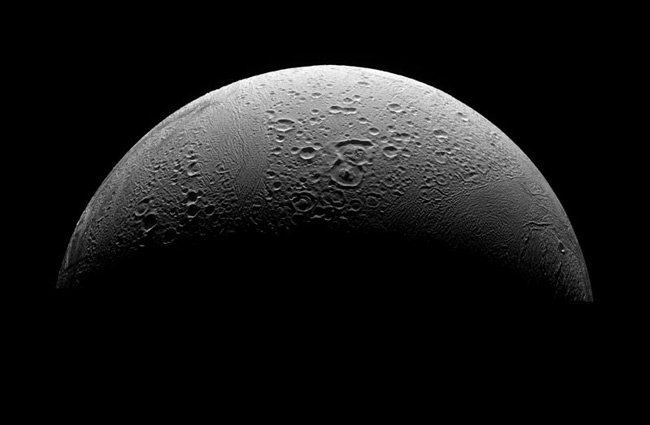Spacecraft Beams Back New Views of Saturn Moon Despite Glitch

This story was updated at 5:40 p.m. EDT.
The Cassinispacecraft has beamed home the most detailed views yet of Saturn?s moonEnceladus despite a software glitch that prevented a key instrument fromsampling the satellite?s geyser-like ice plumes during a flyby.
Cassini whippedby Enceladus on Wednesday at a clip of about 32,000 mph (51,499 kph)during the first of several swings past the icy moon of its extended mission.Scientists on Earth were hoping not only to photograph the moon, but also determinethe composition of its water-ice geysers using a particle analyzingspectrometer and other instruments.
But onetool, known as the Cosmic Dust Analyzer and Ion and Neutral Mass Spectrometer,hung up while switching between two versions of software and did not recorddata as Cassini flew through the plumes.
?Right now,we don?t know exactly what happened,? the instrument?s principal investigatorRalf Srama, of the Max Planck Institute of Astrophysics in Heidelberg, Germany,told SPACE.com. ?We think it was some kind of timing issue.?
Whateverthe cause, the glitch popped up at just the wrong time - as Cassini passed 120miles (193 km) above Enceladus? southern polar region and skirted through theedges of water-ice plumes gushingfrom cracks in the moon?s surface. The instrument was unable to record anydata for several hours during the pass, but has since recovered completely,Srama said.
While thespecific cause of the hiccup is unknown, engineers have isolated it to thein-flight software switch, which worked perfectly during a series of tests onEarth.
Get the Space.com Newsletter
Breaking space news, the latest updates on rocket launches, skywatching events and more!
?We aredisappointed about this, but we were able to pin down the problem,? said Srama.?This means we will not repeat this problem.?
Cassini?sWednesday flyby past Enceladus is the first of four close-up swings past themoon this year, with a similar plume pass slated for Oct. 9, NASA officialssaid.
A wholenew view
Cameras aboardCassini recorded the probe?s approach and departure at Enceladus during theflyby, which skimmed just 30 miles (50 km) above the moon?s surface at thenearest point.
The newviews shed light on Enceladus? north pole, which appeared peppered with cratersand seems much older than the moon?s southern polar region, mission managerssaid.
"Thesenew images are showing us in great detail how the moon's north pole differsfrom the south, an important comparison for working out the moon's obviouslycomplex geological history," said Carolyn Porco, Cassini imaging teamleader and the Space Science Institute in Boulder, Colo., in a statement lateThursday. "And the success of yesterday's daring and very low-altitudeflyby means this coming summer's very close encounter, when we get exquisitelydetailed images of the surface sources of Enceladus' south polar jets, shouldbe an exciting 'next big step' in understanding just how the jets arepowered."
AlthoughCassini?s cosmic dust-analyzing spectrometer failed to observe the compositionand size of Enceladus?plume material, four other instruments functioned perfectly, missionmanagers said.
Cassini firstspotted the plumes of Enceladus in 2005. The icy material spewing out ofthe moon?s southern fissures may point to an ocean just beneath the surface andprovide the raw material that makes up Saturn?s wispy E-ring, mission managerssaid.
?It wasvery exciting,? Srama said of the flyby, adding that he is looking ahead toCassini?s next close swing past the icy moon. ?Enceladus was really anoutstanding target ? our contribution to understanding it will have to waituntil the next time.?
- VIDEO: Enceladus, Cold Faithful
- IMAGES: Cassini's Latest Discoveries
- Special Report: Cassini's Mission to Saturn
Join our Space Forums to keep talking space on the latest missions, night sky and more! And if you have a news tip, correction or comment, let us know at: community@space.com.

Tariq is the Editor-in-Chief of Space.com and joined the team in 2001, first as an intern and staff writer, and later as an editor. He covers human spaceflight, exploration and space science, as well as skywatching and entertainment. He became Space.com's Managing Editor in 2009 and Editor-in-Chief in 2019. Before joining Space.com, Tariq was a staff reporter for The Los Angeles Times covering education and city beats in La Habra, Fullerton and Huntington Beach. In October 2022, Tariq received the Harry Kolcum Award for excellence in space reporting from the National Space Club Florida Committee. He is also an Eagle Scout (yes, he has the Space Exploration merit badge) and went to Space Camp four times as a kid and a fifth time as an adult. He has journalism degrees from the University of Southern California and New York University. You can find Tariq at Space.com and as the co-host to the This Week In Space podcast with space historian Rod Pyle on the TWiT network. To see his latest project, you can follow Tariq on Twitter @tariqjmalik.
